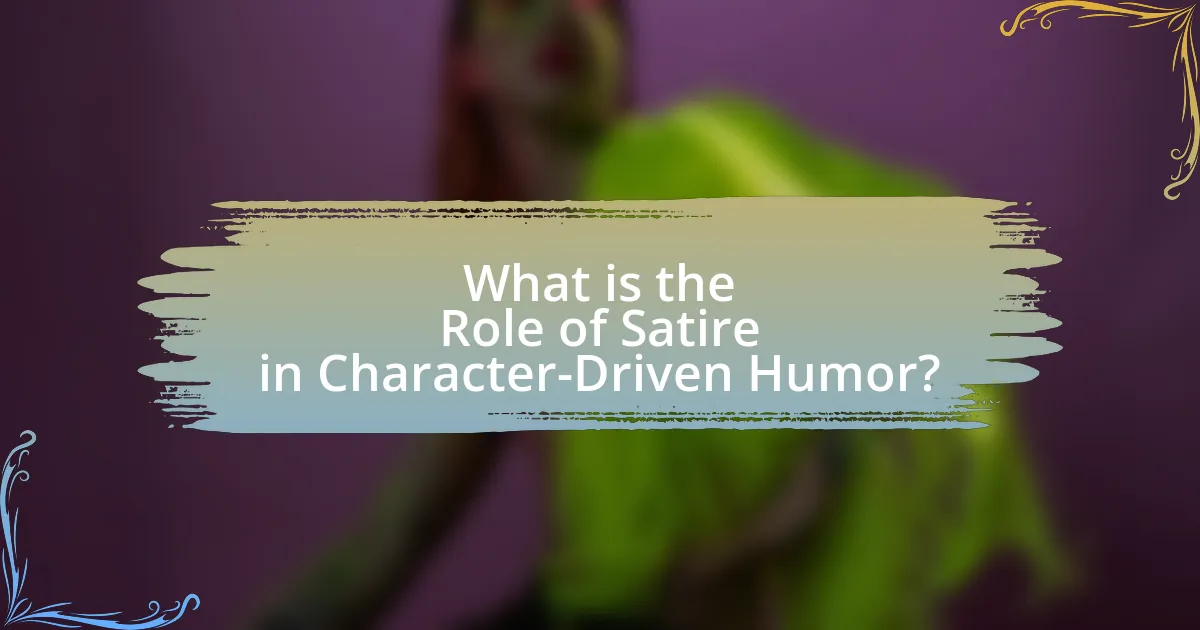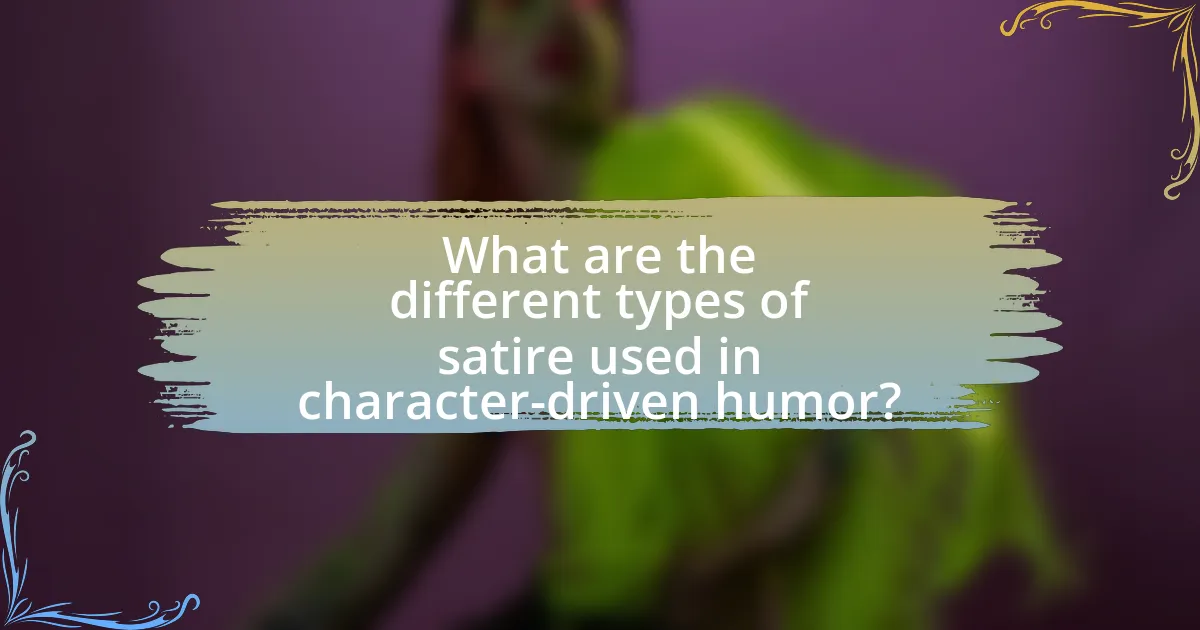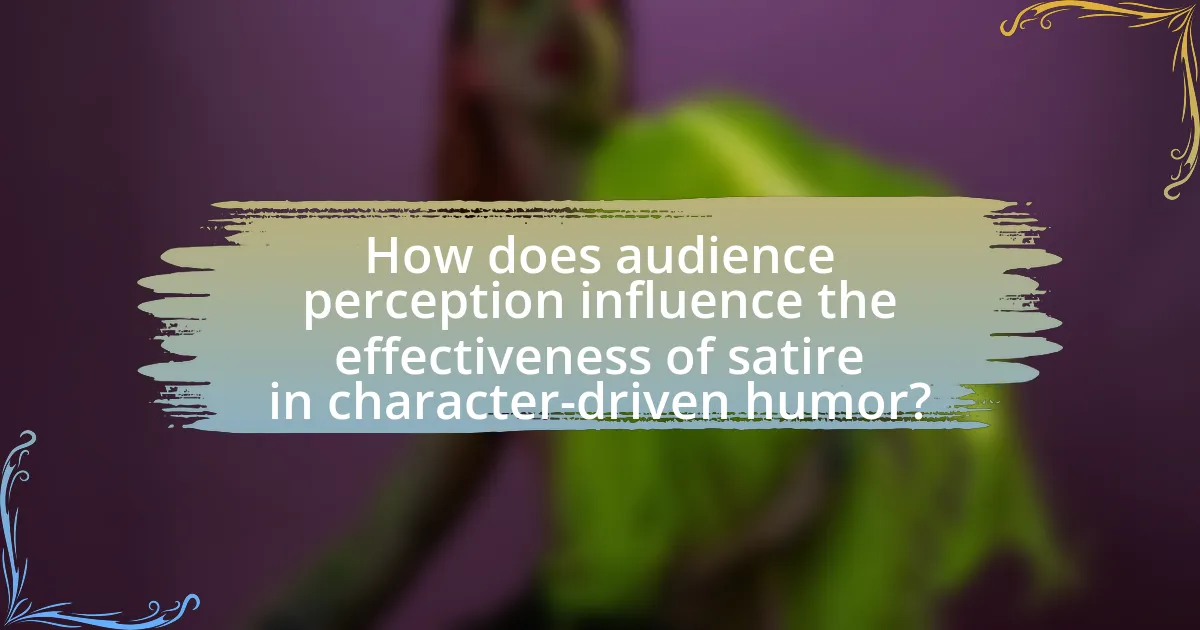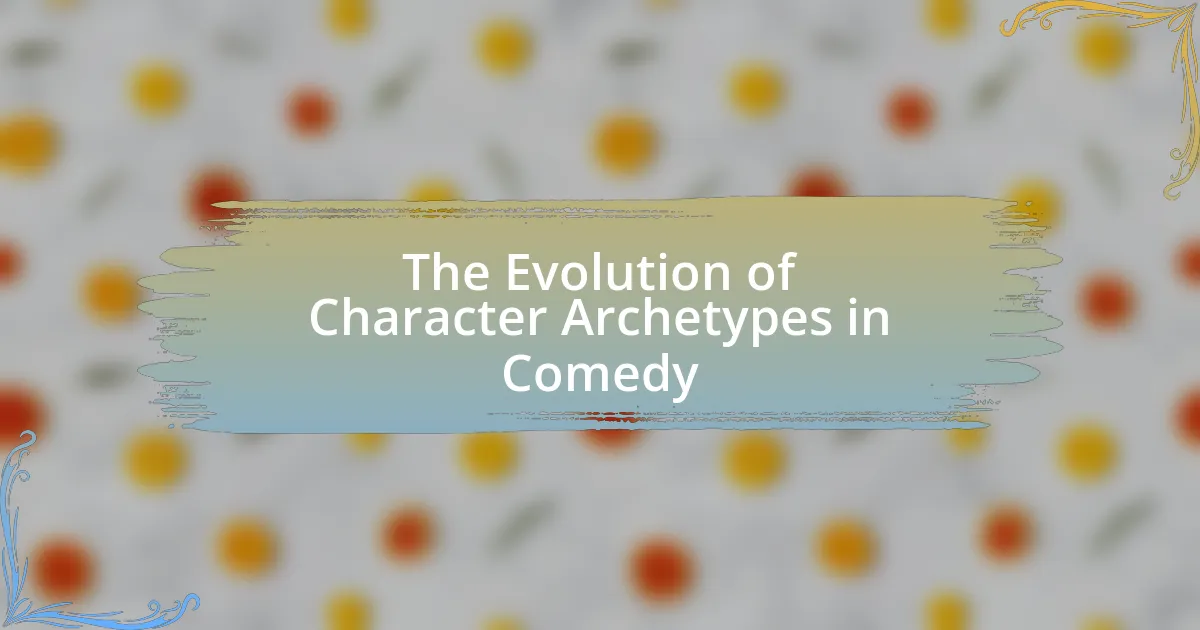The article examines the role of satire in character-driven humor, highlighting how exaggerated traits and situations critique societal norms and human behaviors. It discusses the enhancement of humor through satire by amplifying character flaws, employing irony, and providing social critique, as seen in examples like “The Office.” Key elements such as character development, backstory, and audience perception are explored, illustrating how these factors influence the effectiveness of satire. Additionally, the article differentiates between various types of satire, including parody and social versus political satire, while emphasizing best practices for crafting impactful character-driven satire.

What is the Role of Satire in Character-Driven Humor?
Satire plays a crucial role in character-driven humor by using exaggerated traits and situations to critique societal norms and human behaviors. This form of humor allows for a deeper exploration of characters, as their flaws and absurdities are highlighted, making them relatable and often more humorous. For instance, in television shows like “The Office,” characters embody exaggerated stereotypes that reflect real-life workplace dynamics, allowing audiences to laugh while also recognizing the underlying truths about office culture. This duality of humor and critique enhances the comedic impact, making satire an effective tool in character-driven narratives.
How does satire enhance character-driven humor?
Satire enhances character-driven humor by providing a critical lens through which the flaws and absurdities of characters are exaggerated, making their traits more pronounced and humorous. This amplification of character traits allows audiences to recognize and relate to the exaggerated behaviors, often reflecting societal norms and issues. For instance, in works like “The Office,” the satirical portrayal of office culture highlights the quirks of characters like Michael Scott, making their incompetence both relatable and laughable. This technique not only entertains but also encourages viewers to reflect on the underlying truths about human behavior and societal expectations, thus deepening the humor derived from character interactions.
What are the key elements of satire in humor?
The key elements of satire in humor include exaggeration, irony, and social critique. Exaggeration amplifies characteristics or situations to highlight absurdities, making the subject matter more humorous and impactful. Irony involves a contrast between expectations and reality, often revealing deeper truths about society or human behavior. Social critique serves to challenge prevailing norms, behaviors, or institutions, prompting audiences to reflect on societal issues. These elements work together to create a humorous yet thought-provoking commentary, as seen in works like Jonathan Swift’s “A Modest Proposal,” which uses these techniques to address serious social problems through humor.
How do characters embody satire in their roles?
Characters embody satire in their roles by exaggerating traits and behaviors to critique societal norms and human follies. For instance, in works like “The Office,” characters such as Michael Scott represent the absurdities of corporate culture through their misguided actions and lack of self-awareness, highlighting the flaws in workplace dynamics. This method of characterization allows audiences to recognize and reflect on real-life issues, as the satirical portrayal serves to both entertain and provoke thought about the underlying truths of human behavior and societal structures.
Why is character development important in satire?
Character development is crucial in satire because it allows for the creation of relatable and exaggerated personas that effectively highlight societal flaws. Well-developed characters serve as vehicles for satire, enabling audiences to engage with the humor while reflecting on the underlying issues being critiqued. For instance, in Jonathan Swift’s “A Modest Proposal,” the character’s extreme perspective underscores the absurdity of societal indifference to poverty, making the satire more impactful. This connection between character depth and social commentary enhances the effectiveness of the satire, as audiences are more likely to recognize and reflect on the absurdities presented through these characters.
How does character backstory influence satirical humor?
Character backstory significantly influences satirical humor by providing context that enhances the absurdity or irony of a character’s actions and beliefs. A well-developed backstory allows audiences to understand the motivations and flaws of a character, making the satire more relatable and impactful. For instance, a character with a history of privilege may be portrayed in a satirical light when they exhibit ignorance about social issues, highlighting the disparity between their experiences and those of others. This technique is evident in works like “The Office,” where characters’ backgrounds inform their comedic interactions, amplifying the humor through situational irony and character-driven conflicts.
What traits make characters effective in satire?
Effective characters in satire possess traits such as exaggeration, absurdity, and relatability. Exaggeration amplifies their flaws or characteristics, making them more humorous and recognizable, as seen in characters like the pompous politician in “Veep.” Absurdity introduces illogical situations that highlight societal issues, exemplified by the surreal antics of characters in “The Simpsons.” Relatability allows audiences to connect with the characters’ experiences, enhancing the satirical message, as demonstrated by the everyday struggles of characters in “Parks and Recreation.” These traits collectively enable satire to critique societal norms and provoke thought while entertaining the audience.

What are the different types of satire used in character-driven humor?
The different types of satire used in character-driven humor include parody, exaggeration, and irony. Parody mimics the style of a particular genre or individual to highlight flaws or absurdities, often using recognizable traits of the character to create humor. Exaggeration amplifies certain characteristics or behaviors of a character to an absurd level, making their flaws more apparent and humorous. Irony contrasts the character’s expectations with reality, often revealing deeper truths about human nature or societal norms. These forms of satire effectively critique social issues while entertaining audiences, as seen in works like “The Office,” where character quirks and workplace dynamics are exaggerated for comedic effect.
How do various forms of satire manifest in character-driven narratives?
Various forms of satire manifest in character-driven narratives through the exaggeration of character traits, the use of irony, and the critique of societal norms. In character-driven narratives, authors often create exaggerated personas that embody specific flaws or societal issues, allowing for humor and critique to emerge from their interactions and conflicts. For example, in works like “The Office,” characters such as Michael Scott exemplify incompetence and ignorance, serving as a satirical commentary on corporate culture. Irony is also prevalent, where characters may hold beliefs or exhibit behaviors that starkly contrast with the reality around them, highlighting absurdities in human behavior and societal expectations. This technique is evident in novels like “Catch-22,” where the protagonist’s experiences reveal the illogical nature of war and bureaucracy. Overall, satire in character-driven narratives effectively critiques social issues while engaging audiences through humor and relatable character experiences.
What is the difference between parody and satire in character humor?
Parody and satire in character humor differ primarily in their intent and execution. Parody imitates the style or character of a specific work or individual for comedic effect, often exaggerating traits to entertain, while satire critiques societal norms, behaviors, or institutions through humor, aiming to provoke thought or change. For example, a parody of a famous character might mimic their speech and mannerisms for laughs, whereas a satirical portrayal might highlight the character’s flaws to comment on broader societal issues. This distinction is crucial in understanding how humor can serve both entertainment and social commentary.
How does social satire differ from political satire in character-driven humor?
Social satire differs from political satire in character-driven humor primarily in its focus; social satire critiques societal norms and behaviors, while political satire targets government actions and political figures. Social satire often employs characters that embody societal stereotypes or issues, such as class disparity or cultural trends, to highlight absurdities in everyday life. In contrast, political satire uses characters that represent political ideologies or leaders, aiming to expose corruption or incompetence within the political system. For example, shows like “The Office” utilize social satire to comment on workplace culture, whereas “Saturday Night Live” employs political satire to lampoon politicians and their policies. This distinction is crucial as it shapes the themes and targets of the humor, influencing audience reception and engagement.
What role does irony play in character-driven satire?
Irony serves as a critical mechanism in character-driven satire by highlighting the discrepancies between characters’ perceptions and reality. This contrast often exposes the flaws, hypocrisy, or absurdities of the characters, making their actions and beliefs subject to ridicule. For instance, in works like “The Office,” characters often exhibit ironic traits, such as Michael Scott’s misguided attempts at leadership, which reveal deeper truths about workplace dynamics and human behavior. This use of irony not only enhances comedic effect but also encourages audiences to reflect on societal norms and individual shortcomings, thereby reinforcing the satirical commentary.
How can irony enhance comedic timing in character interactions?
Irony enhances comedic timing in character interactions by creating a contrast between expectations and reality, which can lead to humorous misunderstandings or revelations. When characters express beliefs or intentions that are contradicted by their actions or circumstances, the resulting irony can heighten the comedic effect. For example, in sitcoms, a character may confidently assert they will succeed in a task, only for the audience to know that their incompetence will lead to failure, generating laughter through the anticipation of the inevitable outcome. This technique is supported by the principle of incongruity in humor theory, which suggests that humor arises when there is a discrepancy between what is expected and what actually occurs, making irony a powerful tool for comedic timing.
What are examples of irony in character-driven satirical works?
Examples of irony in character-driven satirical works include the use of characters who embody the very flaws they criticize, such as in George Orwell’s “Animal Farm,” where the pigs, who lead a rebellion against human oppression, ultimately become indistinguishable from the tyrants they replaced. This irony highlights the hypocrisy of power and the cyclical nature of corruption. Another example is in Jonathan Swift’s “A Modest Proposal,” where Swift ironically suggests that the impoverished Irish sell their children as food to solve economic issues, exposing the indifference of the British elite towards the suffering of the Irish. These instances of irony serve to underscore the absurdity of societal norms and provoke critical reflection on moral and ethical issues.

How does audience perception influence the effectiveness of satire in character-driven humor?
Audience perception significantly influences the effectiveness of satire in character-driven humor by determining how well the audience understands and relates to the satirical elements presented. When an audience possesses a shared cultural context or familiarity with the characters being satirized, they are more likely to appreciate the humor and critique embedded in the satire. For instance, studies have shown that audiences who recognize the exaggerations of character traits in political satire are more likely to engage with the humor, as they can connect the satire to real-world events or personalities. This connection enhances the impact of the satire, making it a powerful tool for social commentary. Conversely, if the audience lacks the necessary context or understanding, the satire may fall flat, failing to elicit the intended response. Thus, audience perception acts as a crucial filter that can either amplify or diminish the effectiveness of satire in character-driven humor.
What factors affect audience reception of satirical characters?
Audience reception of satirical characters is primarily influenced by cultural context, familiarity with the subject matter, and the effectiveness of the satire itself. Cultural context shapes how humor is interpreted; for example, satire that critiques political figures may resonate differently in various political climates. Familiarity with the subject matter allows audiences to grasp the nuances of the satire, as seen in shows like “Saturday Night Live,” where viewers with knowledge of current events appreciate the humor more deeply. The effectiveness of the satire, which includes the wit and creativity of the portrayal, also plays a crucial role; research indicates that well-crafted satire can enhance audience engagement and provoke critical thinking, as demonstrated in studies on media consumption and humor perception.
How does cultural context shape the understanding of satire?
Cultural context significantly shapes the understanding of satire by influencing the values, beliefs, and social norms that inform humor. Satire often relies on shared knowledge and experiences within a specific culture, making it effective when the audience recognizes the targets of the satire, such as political figures or societal issues. For instance, Jonathan Swift’s “A Modest Proposal” critiques British policy towards Ireland, and its impact hinges on the audience’s awareness of the historical and political context of 18th-century Ireland. Without this cultural backdrop, the satirical message may be lost or misinterpreted, demonstrating that cultural context is essential for the effective communication and reception of satire.
What role does timing play in audience engagement with satirical humor?
Timing is crucial in audience engagement with satirical humor, as it determines the effectiveness of the humor in relation to current events or social contexts. When satire is delivered at the right moment, it resonates more deeply with the audience, enhancing relatability and emotional impact. For instance, satirical commentary on political events is often most engaging when it coincides with public discourse, as seen in programs like “Saturday Night Live,” which often parodies political figures shortly after significant news breaks. This synchronicity amplifies the humor’s relevance and sharpens its critique, making it more likely to engage and provoke thought among viewers.
How can creators effectively use satire in character-driven humor?
Creators can effectively use satire in character-driven humor by developing exaggerated character traits that reflect societal flaws or absurdities. This approach allows the audience to recognize and critique real-world issues through the lens of humor. For instance, characters like Michael Scott from “The Office” embody incompetence and ignorance, highlighting workplace dynamics and social norms. By placing these characters in relatable scenarios, creators can provoke thought while entertaining, as seen in shows like “Parks and Recreation,” where characters satirize political processes. This method not only engages viewers but also encourages them to reflect on the underlying messages, making satire a powerful tool in character-driven narratives.
What techniques can writers employ to develop satirical characters?
Writers can develop satirical characters by employing exaggeration, irony, and caricature. Exaggeration amplifies traits or behaviors to absurd levels, making the character’s flaws or absurdities more apparent, as seen in works like “The Simpsons,” where characters embody extreme stereotypes. Irony creates a contrast between the character’s perception and reality, highlighting hypocrisy or foolishness, which is effectively used in Jonathan Swift’s “A Modest Proposal.” Caricature simplifies and distorts features to emphasize specific characteristics, allowing readers to quickly grasp the satirical intent, as demonstrated in political cartoons. These techniques collectively enhance the humor and critique inherent in satire, making the characters memorable and impactful.
How can humorists balance satire with character depth?
Humorists can balance satire with character depth by creating multi-dimensional characters who embody the themes of their satire. This approach allows humorists to critique societal norms while ensuring that characters resonate emotionally with the audience. For instance, in the television series “The Office,” characters like Michael Scott are portrayed with flaws and vulnerabilities, making the satirical commentary on corporate culture more impactful. By developing characters with relatable traits and backstories, humorists can engage the audience on a deeper level, enhancing the effectiveness of their satire. This method not only entertains but also provokes thought, as viewers reflect on the underlying social issues presented through the characters’ experiences.
What are best practices for crafting character-driven satire?
Best practices for crafting character-driven satire include developing well-rounded characters, using exaggeration effectively, and ensuring that the satire serves a purpose. Well-rounded characters allow audiences to connect emotionally, making the satire more impactful. Exaggeration highlights flaws and absurdities in the characters or situations, enhancing the comedic effect while drawing attention to societal issues. Additionally, the satire should aim to provoke thought or inspire change, rather than merely entertain. This approach aligns with the principles of effective satire, as seen in works by authors like Jonathan Swift, who used character-driven narratives to critique societal norms and behaviors.





